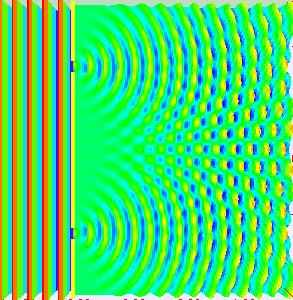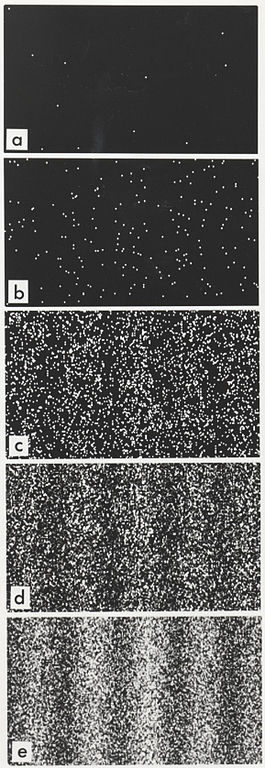The Double-Slit Test

This animation illustrates wave interference in a double-slit test.
One way of distinguishing waves and particles is to conduct a double-slit test. In a double slit test, either particles or waves are sent toward a barrier with two narrow slits in it. Waves produce interference patterns on the other side of the barrier; particles do not. For example, imagine throwing a bunch of pebbles toward a wall of cardboard that has two vertical slits just wide enough for pebbles to pass through. Most of the pebbles will bounce off the cardboard; but a few will go through the slits and land somewhere on the other side. After the experiment, you’ll find two piles of pebbles on the opposite side of the wall: one pile directly behind each of the two slits.
If you conduct the experiment with waves, on the other hand, you’ll see something different. Suppose you stand the cardboard wall across the middle of a basin of water. (You can laminate the cardboard first, so it doesn’t get soggy.) If you make waves on one side of the wall, smaller waves will form on the opposite side of each slit. These smaller waves will fan out and produce patterns of constructive and destructive interference as they overlap each other. The same thing happens with light. If you shine a laser beam at two narrow slits, an interference pattern appears on the other slide.
In this simulation, you can use a double-slit test to experiment with wave interference. Click the “Slits” experiment, then select “Two Slits” from the drop-down menu on the right. Try adjusting the slit width, slit separation, wave frequency, and wave amplitude to see how these parameters affect the interference pattern. You can also move the barrier left or right to give more or less space for the interference to occur. You can choose between three different types of waves by clicking the appropriate icons: water waves, sound waves, and light waves. With light waves, you can also select the “Screen” option to visualize the interference pattern as it appears when the light reaches a flat surface or detector screen.

Ok, what about electrons? Do they behave as waves or particles in a double-slit experiment? The answer, oddly, is both! What I mean is this. When any individual electron passes through a slit then hits a detector film somewhere on the other side, it makes a single dot on the film, just as a particle would. But if you fire a whole lot of electrons toward the slits, you see an interference pattern on the detector film, just as you’d expect if electrons were waves rather than particles.

This sequence of photographs shows the interference pattern produced by electrons in a double-slit test.
Now, here’s the really peculiar thing. The interference pattern shows up even if you send the electrons through the slits one at a time! Each electron is somehow interfering with itself! Apparently, each electron behaves as a wave when it goes through the slits, interfering with itself on the other side. But when it hits the detector film, the electron acts like a particle, and makes just a single dot on the film. Yet, somehow, this particle-like manifestation of the electron is more likely to land on regions corresponding to constructive interference (i.e., parts of the film where constructive interference occurred while the electron was behaving as a wave), and less likely to land in regions corresponding to destructive interference.
If you cover one of the slits, the interference pattern doesn’t form. Moreover, if you move the detector film very close to the slits (too close for interference to occur) in order to detect which slit an electron passes through, you always find that each electron passes through one slit or the other, never both. It almost seems as though the electron knows ahead of time where the detector film is going to be, and changes its behavior accordingly! Spooky.
Electrons aren’t the only particles that behave this way in double-slit tests. The same thing happens with significantly larger particles, too. Double-slit experiments have been done with whole atoms, and even large molecules consisting of over 100 atoms, all with similar results.See this news article for more details.
Of course, this doesn’t happen with macroscopic particles like pebbles, grains of sand, or dust. Why macroscopic particles follow different laws than microscopic particles, though, is a mystery. After all, macroscopic things are supposed to be made of microscopic things, so shouldn’t the same laws apply to both? This puzzle is not easily solved. A number of possible explanations have been proposed, but none has gained consensus from the physics community as a whole.
Before plunging deeper into this issue, it will be worthwhile to reflect for a moment on the nature of measurement and observation. We’ll talk about that on the next page.